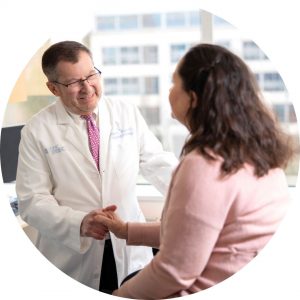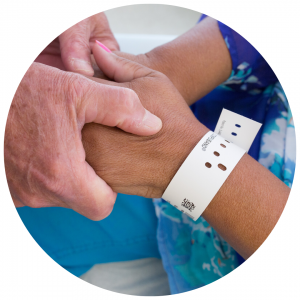 Surgical Oncologist Philip Spanheimer, MD, discusses four common breast cancer myths and misconceptions that patients ask about care, treatment and diagnosis.
Surgical Oncologist Philip Spanheimer, MD, discusses four common breast cancer myths and misconceptions that patients ask about care, treatment and diagnosis.
While these are general guidelines in care and treatment, each patient is unique. Be sure to talk with your care team about your treatment plan, desired outcomes and quality of life, and other important decisions as you care for your breast cancer diagnosis.
 Myth: Patients without a family history of breast cancer will never be diagnosed with breast cancer.
Myth: Patients without a family history of breast cancer will never be diagnosed with breast cancer.
False.
“A majority of our patients [at the N.C. Cancer Hospital] don’t have any family history of breast cancer,” Spanheimer says. Other factors may contribute to developing breast cancer, and mammogram screenings can help detect breast cancer. Anyone with breast tissue can develop breast cancer, including men.
“Family history is a strong risk factor for the development of breast cancer,” Spanheimer says. Family risk refers to having two or more first-degree relatives (such as a mother, sister or daughter) or second-degree relatives (such as an aunt, niece or grandmother) who have had breast cancer. In some cases, a strong family history of breast cancer is linked to having an abnormal gene associated with a high risk of breast cancer, such as the BRCA1 or BRCA2 gene.
 Myth: All breast cancer patients have the same treatment plan.
Myth: All breast cancer patients have the same treatment plan.
False.
Breast cancer is primarily treated with three approaches: surgery, radiation and systemic therapy (which can include hormonal therapy or chemotherapy).
“We look at a variety of factors, including individual tumor characteristics and patient-specific characteristics,” Spanheimer says.
Spanheimer says physicians and care teams will work with patients to determine the best treatment that will minimize the risk of breast cancer recurrence. As part of this, care teams will also work to minimize the potential for complications and minimize side effects.
 Myth: More extensive surgery will help a patient live longer.
Myth: More extensive surgery will help a patient live longer.
False.
One patient concern is around having surgery done to both breasts, even if the cancer is present on only one side.
“We’re frequently asked about contralateral prophylactic mastectomy,” Spanheimer says, which is the removal of the healthy breast in a patient who has or has had breast cancer in the other breast. “In patients without mutations, it’s true that it can reduce the probability of having a diagnosis on the other side, but that is not associated with living longer,” he said.
Spanheimer notes that contralateral prophylactic mastectomy does increase the potential for complications, and having more surgery on the other side doubles that probability.
 Myth: If a patient gets a mastectomy, chemotherapy is not needed.
Myth: If a patient gets a mastectomy, chemotherapy is not needed.
False.
Chemotherapy treats the entire body, which allows treatment of the potential for there to be disease that is too small to detect.
“The decision to have chemotherapy is based on the risk of you having a recurrence —a metastasis— somewhere in your body, and the potential of chemotherapy to reduce that,” Spanheimer says. “There is no situation where the decision for breast-conserving therapy or mastectomy plays into the decision for chemotherapy.”
Chemotherapy is considered a systemic therapy because it travels throughout the body, and can treat disease that has spread to parts of the body away from the original tumor. Local treatments like surgery and radiation affect only one part of the body.
